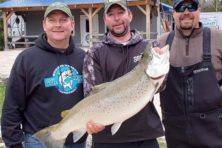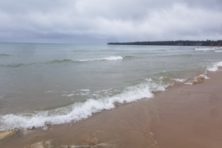Wild Things: The Year of the Trophy Trout
- Share
- Tweet
- Pin
- Share
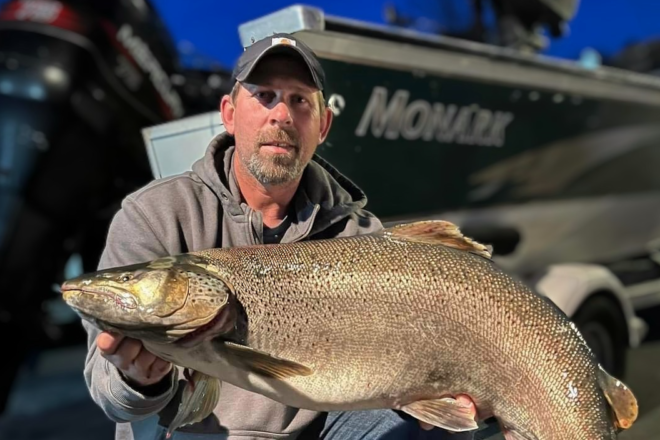
Top 5 fish in tourney all more than 20 pounds
by KEVIN NAZE, [email protected], Peninsula Pulse contributor
Ryan Younk’s 35-inch, 22.81-pound brown trout – one of five larger than 20 pounds – won the first-place prize of $1,000 in the 35th Baileys Harbor Brown Trout Tournament April 13-16.
Younk, of Forestville, fished out of Algoma but said Hooked Up Tackle wasn’t open when he came in off the water, so he weighed in at Howie’s Tackle in Sturgeon Bay.
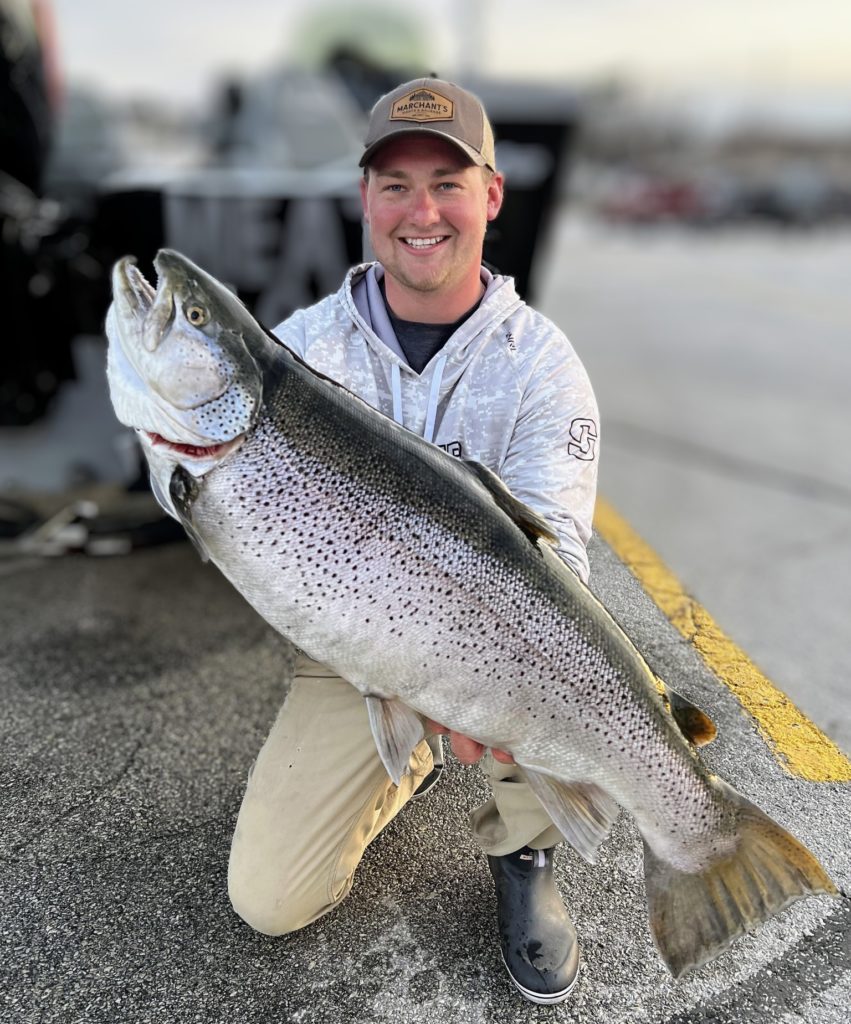
Four other 20-pound-plus trophies were caught, including Zach Marchant’s 21.64-pounder. Marchant, of Brussels, was fishing the bay with Beau Schartner and Tory Jandrin when the trout hit.
“Couldn’t get it off the bottom for the majority of the fight,” Marchant said. “Howie’s was closed when we got in, so we went to Hooked Up.”
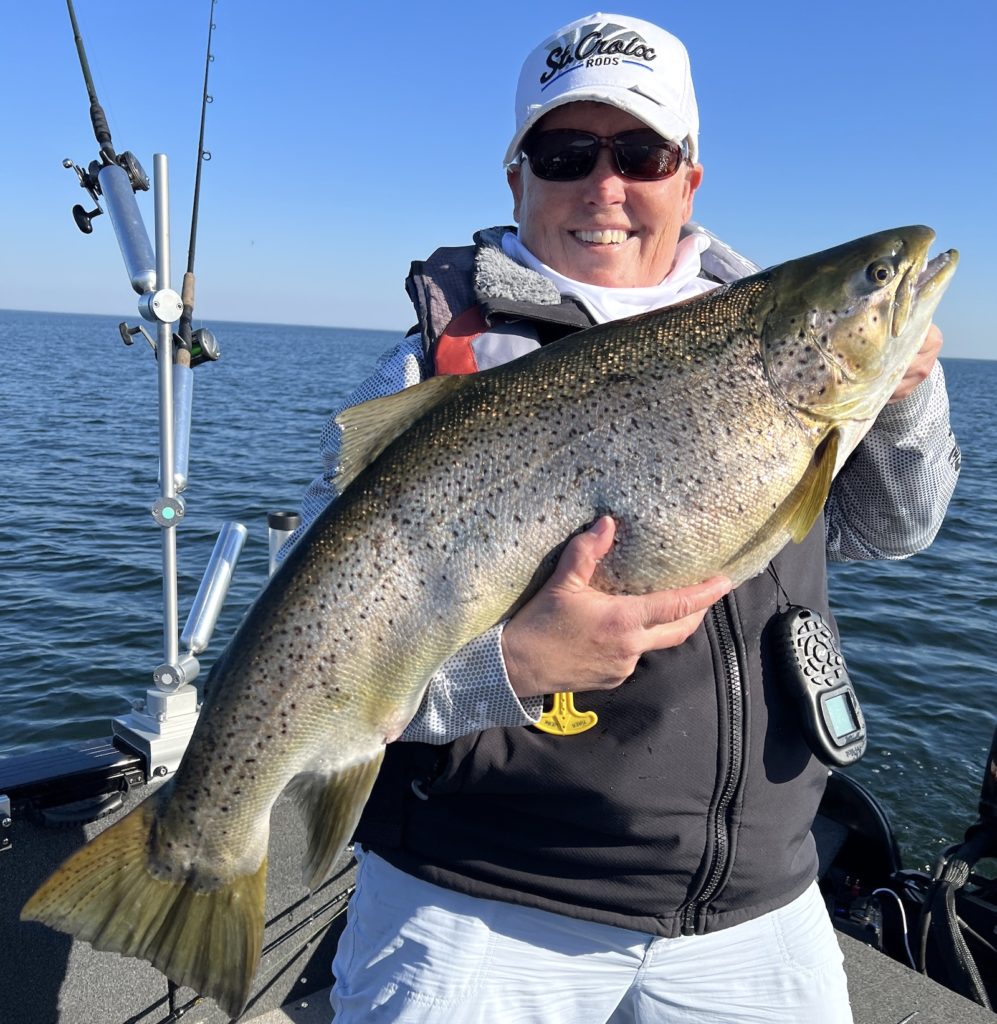
Third place – another bayside fish – was a 21.25-pounder caught by Capt. Barb Carey of Oxford, president of Wisconsin Women Fish. She weighed her catch at Howie’s.
Fourth and five places were fish of 20.97 and 20.36 pounds, with lengths of 37 and 34.75 inches, respectively. They were weighed at Baileys Harbor by Blaze Woldt, and at Algoma by Scott Bouvette.
The four-day tournament lured 341 entrants and allowed fishing on Green Bay and Lake Michigan waters off Door and Kewaunee counties. The last fish in on the money, in the 25th spot, was a healthy 14.7 pounds. Check out the leaderboard and more photos at facebook.com/BaileysHarborBrownTrout.
Spring Hearing Results
A total of 11,566 people voted on the Department of Natural Resources’ (DNR) spring fish and wildlife rules proposals and Conservation Congress advisory questions, including 775 out-of-state residents. Some of the most interesting topics weren’t rules proposals from the DNR, but rather, advisory questions from the Conservation Congress to gauge public opinion.
The Deer & Elk Committee wanted to know whether hunters would prefer a 16-day November gun deer season starting earlier than it currently does, a 19-day gun season similar to the current metro-zone rules, or the current nine-day gun hunt followed immediately by the 10-day muzzleloader season.
As has happened every other time when hunters’ preferences were gauged, the status quo won big, with 5,725 voting to keep it as it is, compared to 1,393 voting for the first option, and 1,657 for the second.
Other Conservation Congress advisory questions that received more votes in favor than opposed included creating a random draw for bonus antlerless permits, blaze orange for upland game-bird hunting, requiring a grouse stamp to hunt grouse, and doubling the youth wild turkey hunt to four days.
There were also many more votes in support of a ban on wildlife shining from Sept. 15 to Dec. 31, a ban on lead jigs and sinkers of one ounce or less, and developing an outreach program to increase the use of non-lead ammunition.
In close votes, participants didn’t favor expanding the youth deer hunt to four days or creating a spearing season for northern pike.
Check out all the numbers from the rules proposals and advisory questions at dnr.wisconsin.gov/about/wcc/springhearing. The results are nobinding and advisory only. Some, however, could get enough backing to kick-start a legislative rule change.
Earth Day News
Gov. Tony Evers called our state park system and public lands gems of Wisconsin on April 21, a day ahead of Earth Day, while highlighting initiatives in his 2023-25 biennial budget proposal, as well as his 2023-25 capital-budget recommendations.
Evers’ biennial budget proposal seeks more than $30 million to increase funding and staff for the park system, including building projects and facility upgrades. Meanwhile, his capital-budget recommendations include more than $48 million for 23 major projects at state parks and properties, including more than $6 million for an accessible Potawatomi State Park observation tower.
In other news, Evers said that more than 12.9 million trees were planted in Wisconsin last year, with more than 22 million now planted since he signed an order on Earth Day two years ago committing to 75 million new trees in rural and urban areas by 2030.
Deer Meeting April 26
Hunters and others who are interested in deer management are invited to the Door County Deer Advisory Council meeting April 26, 6 pm, in the Door County Government Center’s Chambers Room in Sturgeon Bay. You can attend in person, online at https://us02web.zoom.us/j/87902451294 or by calling 1-301-715-8592. The meeting ID is 879 0245 1294.
The Kewaunee County Deer Advisory Council meeting is set for April 24, 7 pm, at the County Highway Department building, E4280 Cty F in Kewaunee. The Zoom link is https://us02web.zoom.us/j/84020900280, and the phone number is 1-301-715-8592. The meeting ID is 840 2090 0280.
Lake Trout Meetings
The third in a series of four public meetings of the Lake Michigan Lake Trout Commercial Harvest Stakeholder Group was held earlier this week to present information and gather feedback. We’ll take a deeper dive into the issue in the April 28 print edition of the Peninsula Pulse, but in the meantime, find more information at dnr.wisconsin.gov/topic/Fishing/lakemichigan/LakeMichiganLakeTroutManagement.
Free Park Day Passes
Starting May 1, more than 160 libraries across Wisconsin will make nearly 6,300 day passes available. They’re valid for a free, single-day admission for one vehicle at any state park, forest or recreation area. Participating libraries include the Door County branch in Sturgeon Bay, the Algoma and Kewaunee public libraries, and the Brown County Library in Green Bay.
Weekly Water Update
Lake Michigan water levels have risen six inches during the past month, and they are expected to rise three more inches by late May. As of April 21, levels were down four inches from a year ago, but still seven inches higher than the 100-year average. Water levels were down 28 inches from the all-time April high, set in 2020, but they were 39 inches higher than the record monthly low in 1964.


